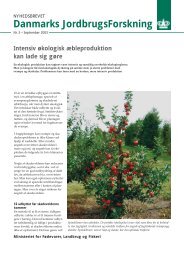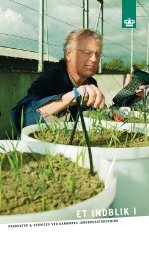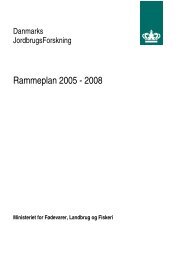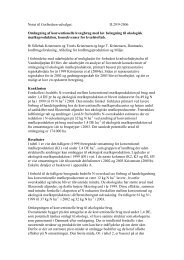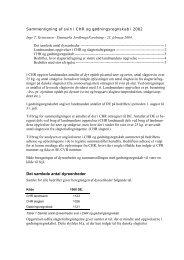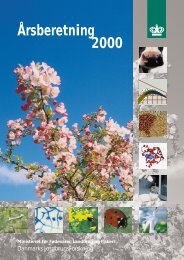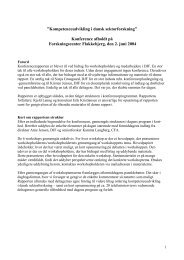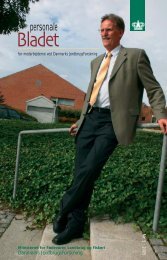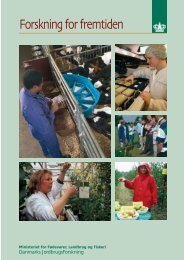Reproduction performances and conditions of group-housed non ...
Reproduction performances and conditions of group-housed non ...
Reproduction performances and conditions of group-housed non ...
You also want an ePaper? Increase the reach of your titles
YUMPU automatically turns print PDFs into web optimized ePapers that Google loves.
- Summary -<br />
SUMMARY<br />
In the last decade the number <strong>of</strong> <strong>group</strong> <strong>housed</strong> <strong>non</strong>-lactating sows has been increasing in<br />
Europe. This is mainly caused by elevated public concern <strong>of</strong> animal welfare with changed<br />
legislation as a consequence. However, among herds with <strong>group</strong> <strong>housed</strong> <strong>non</strong>-lactating sows<br />
there is a huge variation in the reproduction results. The apparently large variation in farrowing<br />
rate <strong>and</strong> litter size indicates that it will be possible to improve these parameters in<br />
some <strong>of</strong> these herds. On this background the overall aim <strong>of</strong> this thesis was to produce<br />
knowledge that managers can implement in their decision-making to improve the reproduction<br />
performance <strong>of</strong> <strong>group</strong> <strong>housed</strong> <strong>non</strong>-lactating sows. The specific aims were to identify<br />
important causes for impaired reproduction performance in <strong>group</strong> <strong>housed</strong> <strong>non</strong>-lactating<br />
sows <strong>and</strong> to develop <strong>and</strong> evaluate indicators suitable for use in decision-making in commercial<br />
sow herds.<br />
First, a review <strong>of</strong> the literature <strong>of</strong> reproduction physiology was carried out (Appendix 1). It<br />
was concluded that the endocrine regulation <strong>of</strong> reproduction might be influenced by energy<br />
intake <strong>and</strong> stress. Since experimental studies had indicated that <strong>group</strong> housing might lead<br />
to unequal feed intake <strong>and</strong> social stress, the hypothesis was put forward that individual<br />
variation in feed intake <strong>and</strong> social stress might cause impaired reproduction performance in<br />
some <strong>group</strong> <strong>housed</strong> <strong>non</strong>-lactating sows. To illuminate this further, two review papers were<br />
written a) to consider the effect <strong>of</strong> energy intake (Paper I) as well as social stress <strong>and</strong> fear<br />
(Paper II) <strong>and</strong> b) to define indicators <strong>of</strong> feed intake, stress <strong>and</strong> fear suitable for use in practice.<br />
A study in 14 herds with different layouts <strong>and</strong> management routines was carried out to<br />
evaluate the defined indicators (Paper III) <strong>and</strong> to investigate whether the indicators were<br />
suitable to express variation in the reproduction performance <strong>of</strong> sows under practical <strong>conditions</strong><br />
(Paper IV).<br />
Paper I<br />
The aim <strong>of</strong> this review was to consider whether the variation in energy intake in a <strong>group</strong> <strong>of</strong><br />
<strong>non</strong>-lactating sows can influence variation in litter size <strong>and</strong> pregnancy rate in practice.<br />
Through a review <strong>of</strong> existing literature with main emphasis on publications after 1980, the<br />
effect <strong>of</strong> energy supply before mating <strong>and</strong> in pregnancy on pregnancy rate <strong>and</strong> litter size<br />
was discussed. Based upon experimental studies, indicating that low ranking sows may<br />
consume considerably less than high ranking sows (e.g. 50-80%) in <strong>group</strong> housing, it was<br />
suggested that the variation in feed intake in a <strong>group</strong> <strong>of</strong> restrictedly fed pregnant female<br />
pigs may be sufficiently severe to influence pregnancy rate <strong>and</strong> litter size.<br />
1




